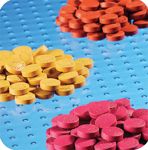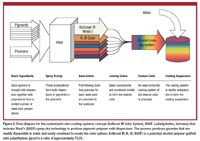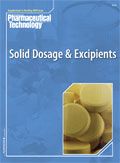The Benefits of Instant-Release Color-Coating Systems
The author discusses a new fillm-coating system to create customized colors and the research an development tools used in conjunction with this system. This article is part of a special supplement on Excipients and Solid Dosage.
Developing a film-coating color for an oral, solid-dose pharmaceutical product comes with some challenges. Creating and choosing the color for an instant-release coating for a new product not only involves working with associates across several areas such as research and development, manufacturing, and marketing, but also often includes the manual process of formulating individual coatings to evaluate color options. Automating the process of developing and evaluating a color formulation helps to save time and reduce costs when developing an oral solid dosage product. This article examines currently applied manual color systems and a new automated color system using excipient technology and specialized software tools.

COURTESY OF THE AUTHOR
Manual color systems
The manual film-coating color-development process can be difficult and time-consuming. Developing a film-coating color involves the selection and formulation of the optimal ratio of polymer to plasticizer to achieve a successful coating. The process of determining the correct pigments, pigment concentrations, and pigment combinations needed to reach a desired color can be tedious. Pigment selection is further complicated by taking into consideration the colorants needed to reach a final color and how the regulatory status of each colorant affects acceptability in different regions of the world. This situation is often the case with iron oxides and aluminum lakes.
Once a film-coating color formulation has been finalized, the process of making the formulation for use in production has to be considered and developed. This process often involves preparing a suspension by adding separately each of the individual ingredients, which include polymers, plasticizers, and pigments. Depending on the film-coating ingredients, as with hypromellose, for example, this process can be time-consuming. In addition, specific colorants may need to be individually processed before use, for example, by reducing the particle size of ingredients, to optimize performance. Colorant testing to ensure that the final film-coating color is consistent from batch to batch adds further complexity.
Immediate-release film coatings
To simplify this process, BASF (Ludwigshafen, Germany) created a new fully formulated color-coating system for immediate release film-coatings using a polyvinyl alcohol polymer grafted onto polyethylene glycol in a ratio of approximately 75:25 (Kollicoat IR). The coatings are manufactured using seven base colors and are fully formulated using globally accepted pigments (i.e., those in accordance with: the US Code of Federal Regulation, Title 21, "Food and Drugs"; the BIRYO limits on trace amounts as specified by Japan's Ministry of Health, Labor and Welfare; and the Dictionary of Pharmaceutical Excipients (Japan)) in combination with a manufacturing process that results in coating granules that are easy to use. Examples of each of the seven base colors are provided in Figure 1.

Figure 1 (FIGURES 1 AND 2 ARE COURTESY OF THE AUTHOR)
As described in Figure 2, each pigment is brought into suspension together with polymers to form seven base color preparations. These preparations form solid dispersions of pigments in the polymer. The free-flowing, nearly dust-free granules, are readily dispersible in water and can be easily combined to create color options. The basic components are combined onsite to form the desired color. A coating system of the desired color is produced, and the coating system is readily dispersible to form the coating suspension.

Figure 2
A key element to this process is the spray-dry technology that produces the pigment–polymer solid dispersion. This process (Xfast, BASF) provides high surface area, solid-dispersion granules consisting of pigment embedded in the coating polymer matrix. These properties of the solid-dispersion granules, combined with the high water solubility of the polyvinyl alcohol–polyethylene glycol copolymer, allow for the fast redispersion into water. Once dispersed using a standard propeller mixer, the coating-systems' coating suspensions are ready to be used in the film-coating process in approximately 20 min.
The Kollicoat IR copolymer offers additional benefits in film-coating applications. The low viscosity, water-soluble copolymer of polyvinyl alcohol and polyethylene glycol provides color film-coatings that exhibit high elasticity. Elasticity is important when dealing with applications where a more flexible film coating is needed to eliminate film cracking that can result when using more brittle coating ingredients. The copolymer's low viscosity allows for increased manufacturing productivity by using high solids-content suspensions of 20% and higher. The adhesive properties of the polyvinyl alcohol–polyethylene glycol copolymer result in film-coated tablets with excellent logo definition. The copolymer also is internally plasticized, which eliminates the potential for plasticizer migration.
Color selection. The color system (Kollicoat IR Coating System, BASF) uses 102 preformulated color options (Color Fan, BASF). A color–combination formula is provided for each color square. As a result, film-coating formulation–development work is not necessary, and color evaluation on a solid oral-dosage form can be completed using the preformulated formulation.
An important part of the color system is the software, which is used to expand the color options by using preformulated recipes to create new colors by adjusting the amounts of base global colors found in a given formulation. For example, a preformulated color can be made lighter or darker by either increasing or decreasing the percentage of one of the formula components, or a wholly new color can be created by adding a new color component or removing one from the original formula. The new color is displayed as a color square on a computer monitor, and the resulting formula can be evaluated in the laboratory either by film casting or coating a tablet.
Alternative color measurement. A color-measurement spectrophotometer can be used to measure the color of another product, a tablet or capsule, for example, in order to match that color. The CIE color scale can be used to generate L*a*b* color values, which define color in a color space. The L* axis represents the color scale from black to white, and the a* and b* axes represent color values from green to red and blue to yellow, respectively. The L*a*b* color values generated are used by the software to provide the closet color match. Manual pigment manipulation and combination are not needed to determine a specific color match. The software provides a measured starting point based on the combination of formulations in the coating system.
Regulatory considerations. The software can provide regulatory guidance for products marketed in the United States, European Union, and Japan with regards to pigment levels on a final dosage form. By factoring in tablet dimensions, specific coating weight gain, colorant concentrations, and daily product dosing, the software determines whether a specific coating formulation exceeds current colorant limits in the US, the EU, and Japan. Using this regulatory software tool, a color formulation can be created and evaluated without having to prepare a test formulation or perform a coating trial. If a specific coating-formulation color exceeds colorant limits, the formulation and color can be adjusted using the software before actual color-coating work is completed in the laboratory.
Conclusion
The application of the new color system (Kollicoat IR coating system) illustrates how pharmaceutical excipient technologies can be combined to make new color options for immediate-release film coatings. The system also is a good tool to increase productivity and reduce the development time encountered in manual color systems.
Phil Butler is a technical sales manager for BASF, 100 Campus Drive, Florham Park, NJ 07932, tel. 973.245.6378, fax. 973.245.6843, philip.butler@basf.com.

Drug Solutions Podcast: A Closer Look at mRNA in Oncology and Vaccines
April 30th 2024In this episode fo the Drug Solutions Podcast, etherna’s vice-president of Technology and Innovation, Stefaan De Koker, discusses the merits and challenges of using mRNA as the foundation for therapeutics in oncology as well as for vaccines.